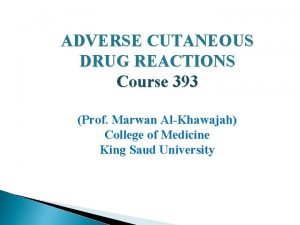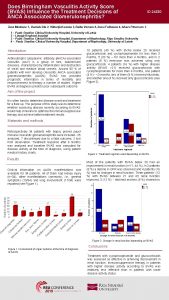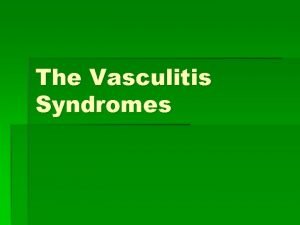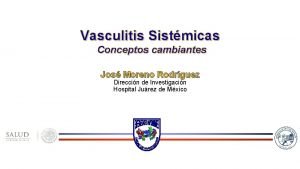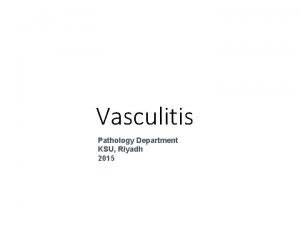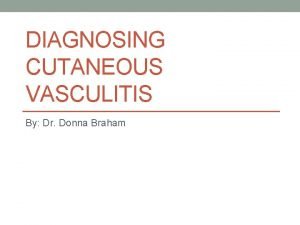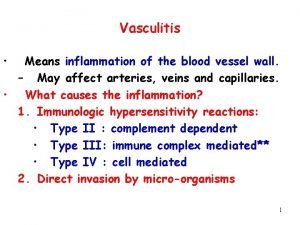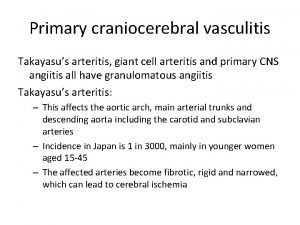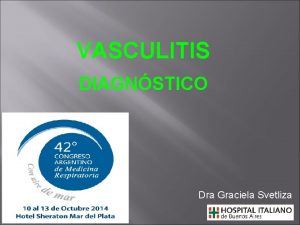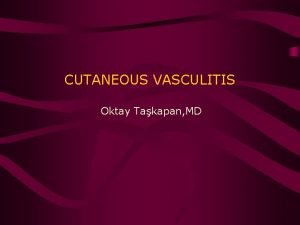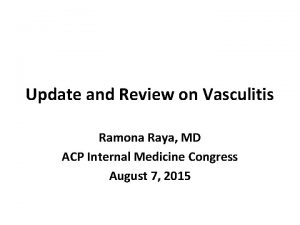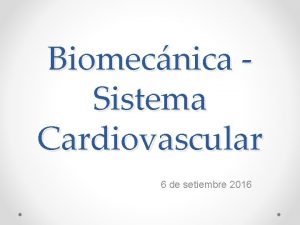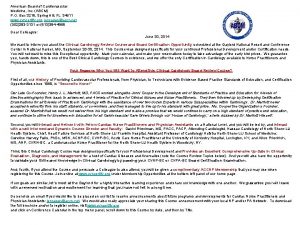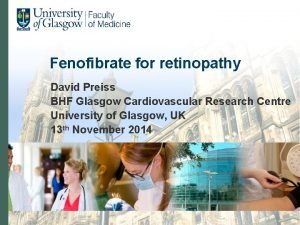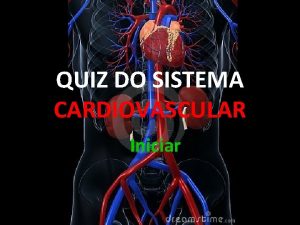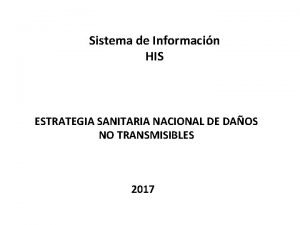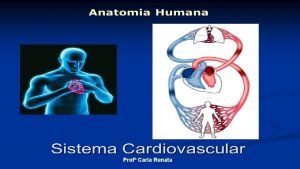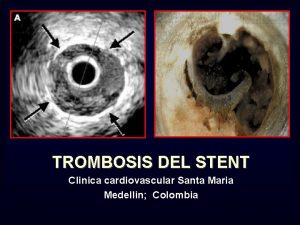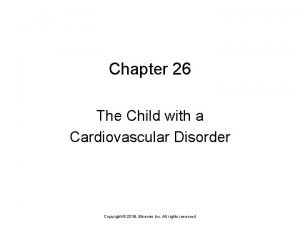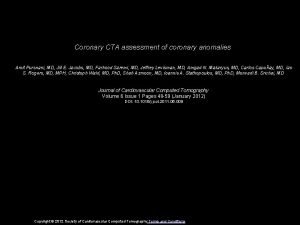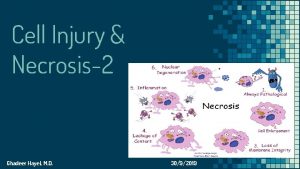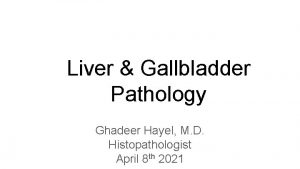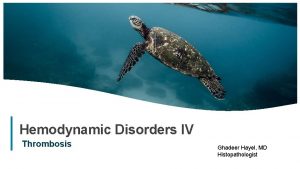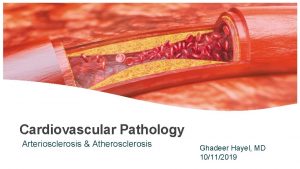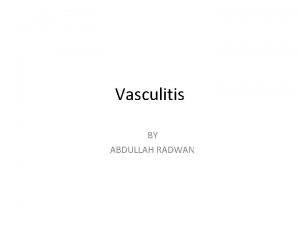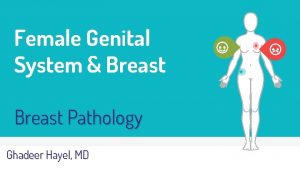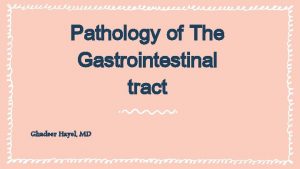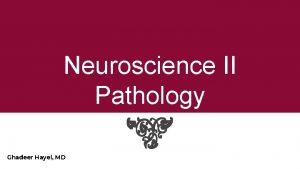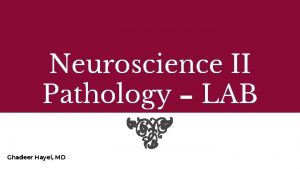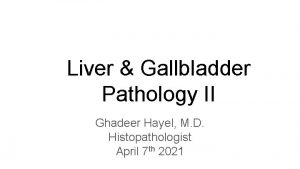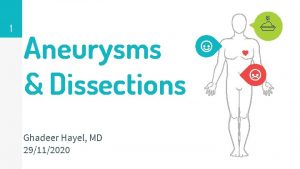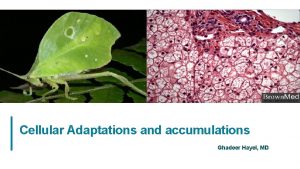Cardiovascular Pathology Vasculitis Ghadeer Hayel MD Histopathologist 22112020
































- Slides: 32

Cardiovascular Pathology Vasculitis Ghadeer Hayel, MD Histopathologist 22/11/2020 1

• Inflammation of the walls of vessels is called vasculitis • It is encountered in diverse clinical settings. • Vessels of any type in virtually any organ can be affected. Clinical manifestations often include: 1. constitutional signs & symptoms: e. g. , fever, myalgias, arthralgias, & malaise. 2. local manifestations of downstream tissue ischemia. 2

• Several vasculitides tend to affect only vessels of a particular size or location, but Most vasculitides affect small vessels; from arterioles to capillaries to venules • 20 primary forms of vasculitis classification schemes according to: vessel diameter, role of immune complexes, presence of specific autoantibodies, granuloma formation, organ specificity, & even population demographics • The two most common mechanisms of vasculitis are: - direct invasion of vascular walls by infectious pathogens - Immune-mediated mechanisms. • Physical & chemical injury, such as irradiation, mechanical trauma, & toxins can also cause vascular damage. 3

Pathogenesis of Noninfectious Vasculitis Immunologic injury in noninfectious vasculitis may be caused by: (1) Immune complex deposition (2) Antineutrophil cytoplasmic antibodies (ANCA) (3) Anti-endothelial cell antibodies. (Anti-EC) (4) Autoreactive T cells 4

Immune Complex–Associated Vasculitis ü This mechanism is supported by the fact that the vascular lesions resemble those found in experimental immune complex mediated conditions. ü Also in some cases contain readily identifiable antibody and complement. ü is a diagnostic challenge; rarely is the specific antigen responsible for immune complex formation known, & in most instances it is not clear whether the pathogenic antigen-antibody complexes are deposited into the vessel wall from the circulation or form in situ. • Systemic lupus erythematosus & polyarteritis nodosa 5

ANCA associated • Patients have circulating antibodies react with neutrophil cytoplasmic antigens (antineutrophil cytoplasmic antibodies (ANCAs). • ANCAs are a heterogeneous group of autoantibodies directed against constituents (usually enzymes) of neutrophil primary granules, monocyte lysosomes. • Two main patterns are recognized by IF studies: 1. Cytoplasmic localization of the staining (c-ANCA), target antigen is proteinase-3 (PR 3), a neutrophil granule constituent. (Anti-proteinase 3) granulomatosis with polyangiitis 2. Perinuclear staining (p-ANCA) & target antigen is myeloperoxidase (MPO). (Anti-myeloperoxidase) microscopic polyangiitis & Churg. Strauss syndrome 6

ANCA associated • These auto-antibodies are directed against cellular constituents without circulating immune complexes. Lesion does not contain antibody and complement; so often described as “pauci-immune. ” 7

Anti-Endothelial Cell Antibodies & Autoreactive T Cells • Antibodies to ECs underlie certain vasculitides, such as Kawasaki disease • Autoreactive T cells cause injury in some forms of vasculitides characterized by formation of granulomas. 8

Classification of Vasculitis Vessel Large Medium Small Disease summary Giant-cell arteritis F, >50. Arteries of head. Takayasu arteritis F, <40. “Pulseless disease” Polyarteritis nodosa Young adults. Widespread. Kawasaki disease <4. Coronary disease. Lymph nodes. Wegener granulomatosis Lung, kidney. c-ANCA. Churg-Strauss syndrome Lung. Eosinophils. Asthma. p-ANCA. Microscopic polyangiitis Lung, kidney. p-ANCA. 9

Temporal (giant cell, cranial) arteritis • A chronic inflammatory disorder affects principally largeto small-sized arteries in the head (the temporal, vertebral, ophthalmic arteries), also affect the aorta, & may cause thoracic aortic aneurysm. • It is the most common form of vasculitis among older adults in developed countries. • Ophthalmic arterial involvement may lead to permanent blindness. Therefore, giant cell arteritis is a medical emergency that requires prompt recognition & treatment. 10

Temporal (giant cell, cranial) arteritis • Histology • granulomatous inflammation • chronic non-specific panarteritis • fragmentation of the internal elastic lamina • Pathogenesis • T Cell mediated immunity 11

Temporal (giant cell, cranial) arteritis • Clinical features • Females > males (~X 4) • > 50 years (rare before 50 years of age) • non-specific constitutional symptoms • Headache, local facial pain & tenderness • ocular symptoms, 50 % (range from diplopia to blindness) • Diagnosis • Biopsy (at least 1 cm) Could be negative (very focal involvement) • Rx: corticosteroids are effective. 12

13

14

Takayasu Arteritis (pulseless disease) • A granulomatous vasculitis of medium & larger arteries affects mainly arch of aorta. • Characterized by transmural fibrous thickening & obliteration of aortic arch & great vessels luminal narrowing of the major branch vessels the origin of great vessels. • Symptoms are secondary to luminal narrowing: ocular disturbances & marked weakening of the pulses in the upper extremities (pulseless disease). • More common in females younger than 40 years and more frequently in Asian countries. • Course of disease is variable , may enter in quiescent stage. 15

16

Polyarteritis nodosa (PAN) • A systemic disease characterized by necrotizing inflammation of small to medium - sized arteries throughout the body (renal and visceral), sparing the pulmonary circulation. • The involvement of the vessels is focal, random & episodic. • It often produces irregular aneurysmal dilatation (coz it weakens the arterial wall) nodularity, and vascular obstruction leading to infarctions. • Acute lesions show segmental transmural necrotizing inflammation extending around the vessel. 17

Polyarteritis nodosa (PAN) • Healed lesions show marked fibrotic thickening of the arterial wall , with associated elastic lamina fragmentation. • All stages of activity may coexist in different vessels or even in the same vessel and this is so characteristic of PAN ongoing and recurrent insults. • Clinical features young adults, males > females , vascular involvement is widely scattered clinical picture can be varied & puzzling. • Diagnosis. . Biopsy • Rx … immunosuppression 18

19

Kawasaki disease (mucocutaneous lymph node syndrome) • Acute febrile illness, large- to medium-sized vasculitis of infants & children (< 4 years) characterized by - Fever, - Lymphadenopathy, - Skin rash - Oral / conjunctival erythema. • 20% have coronary vasculitis , often with aneurysm. • Histology like PAN • Etiology ; unknown (auto-antibodies to ECs) • Self-limited disease, rarely fatal(1%) complications of coronary involvement. 20

Granulomatosis With Polyangiitis • Previously called Wegener granulomatosis. • Classical cases consist of a triad: 1. Granulomatous or necrotizing vasculitis mainly in the lung & upper respiratory tract. 2. Necrotizing granulomas of upper &/or lower respiratory tract 3. Renal involvement • focal necrotizing glomerulonephritis • rapidlly progressive glomerulonephritis • Clinical picture • overlaps with PAN • Males > females, peak at 5 th decade 21

Granulomatosis With Polyangiitis • Diagnosis • Lung biopsy, kidney biopsy, or nasal biopsy, • Prognosis • 80% die within a year (if not treated) • 90% respond to treatment • Pathogenesis • T Cell Mediated. • > 95% PR 3 -ANC positive (Mirrors the clinical coarse ) 22

23

Microscopic polyangiitis (microscopic polyarteritis) or HYPERSENSITIVITY vasculitis OR LEUKOCYTOCLASTIC vasculitis Most cases of microscopic polyangiitis are associated with MPO-ANCA , Although immunoglobulins and complement components can be demonstrated in early skin lesions, most lesions are “pauci-immune” 24

§ Involvement of small vessels (arterioles, capillaries, & venules). § all lesions of the same stage/age. § Skin, mucous membranes, lungs, brain, heart, GIT, kidney & muscles. § In contrast to PAN, necrotizing glomerulonephritis (90%) & pulmonary capillaritis are common • Segmental fibrinoid necrosis of media. • No granulomatous inflammation • Sometimes limited to infiltration of vessel wall by neutrophils with nuclear fragmentation (leucocytoclasia), leukocytoclasatic vasculitis. • A reaction to an Ag such as drugs, microorganisms or hetrologous protein in a previously sensitized patients. • Clinical: hemoptysis, arthralgia, abdominal pain, hematuria, proteinuria, hemorrhage, & muscle pain or weakness. • Except in brain or renal involvement most patients respond to removal of offending antigens & immunosuppression. • Ass : Henoch -schonlein purpura, essential mixed cryoglobulinemia, vasculitis with malignancy 25

26

In allergic granulomatosis and angiitis (Churg-Strauss syndrome) • Rare disease characterized by - necrotizing vasculitis accompanied by granulomas with eosinophilic necrosis. - p-ANCAs are present in A minority of patients. - There is a strong association with allergic rhinitis, bronchial asthma, and peripheral eosinophilia. - Coronary arteritis & myocarditis are the principal causes of morbidity and mortality. 27

28

Thromboangiitis obliterans (Buerger’s Disease) • A condition marked by segmental, thrombosing acute & chronic inflammation of intermediate & small arteries & veins in the limbs with extension to accompanying nerves. • Exclusively seen in heavy smokers males before the age of 35. • Instep claudication followed by pain at rest, might end in gangrene. • Etiology ? Endothelial cell injury by toxins in tobacco. 29

30

31

THANK YOU Insert Image 32
 Ghadeer khum
Ghadeer khum Vasculitis
Vasculitis Sle vasculitis
Sle vasculitis Birmingham vasculitis activity score
Birmingham vasculitis activity score Vasculitis
Vasculitis Wegener's vs churg strauss
Wegener's vs churg strauss Vasculitis anca
Vasculitis anca Vasculitis
Vasculitis Dr donna braham dermatologist
Dr donna braham dermatologist Vasculitis
Vasculitis Takayasu arteritis
Takayasu arteritis Vasculitis
Vasculitis Vasculitis anca
Vasculitis anca Takayasu arteritis
Takayasu arteritis Clasificacion chapel hill vasculitis 2012
Clasificacion chapel hill vasculitis 2012 Sistema cardiovascular sus partes
Sistema cardiovascular sus partes Rias cardiovascular
Rias cardiovascular Prairie cardiovascular consultants springfield il
Prairie cardiovascular consultants springfield il Chapter 16 cardiovascular emergencies
Chapter 16 cardiovascular emergencies Introduction of cardiovascular system
Introduction of cardiovascular system American board of cardiovascular medicine
American board of cardiovascular medicine Bhf glasgow cardiovascular research centre
Bhf glasgow cardiovascular research centre Heart rate during exercise
Heart rate during exercise Sistema cardiovascular quiz
Sistema cardiovascular quiz Riesgo cardiovascular por perimetro abdominal
Riesgo cardiovascular por perimetro abdominal Sistema cardiovascular
Sistema cardiovascular Speed in mapeh
Speed in mapeh Cuestionario aha/acsm
Cuestionario aha/acsm Anatomy blood vessels
Anatomy blood vessels Chapter 11 the cardiovascular system figure 11-3
Chapter 11 the cardiovascular system figure 11-3 Clinica cardiovascular santa maria
Clinica cardiovascular santa maria The child with a cardiovascular disorder chapter 26
The child with a cardiovascular disorder chapter 26 Dr amit pursnani
Dr amit pursnani

